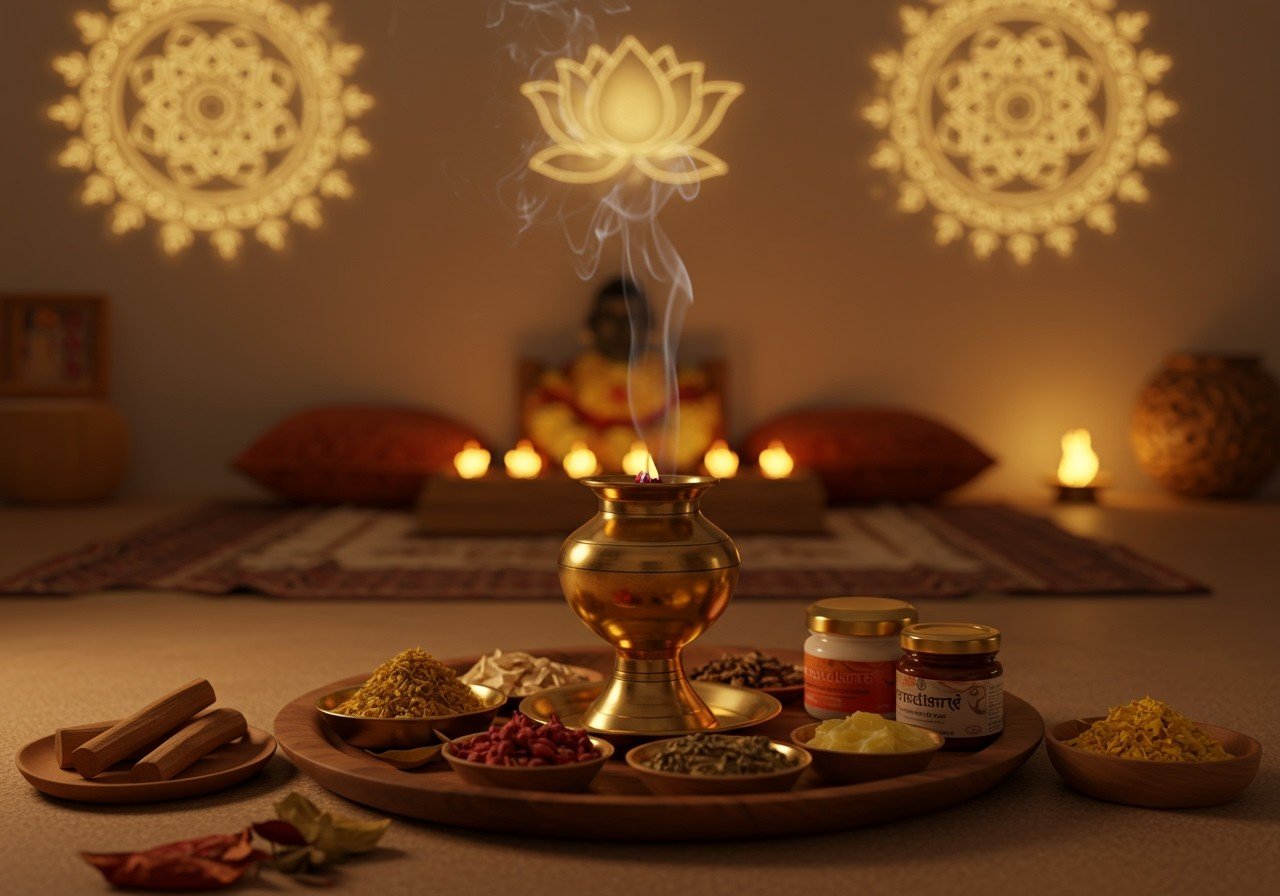Embarking on a Spiritual Journey: Creating a Dhuni at Home

Creating a Dhuni at home is a beautiful way to connect with Indian traditions. This sacred fire ritual, steeped in history and spirituality, symbolizes purification, prayer, and connection with divine energies. Bringing this ancient custom into our modern homes allows us to blend authenticity with the convenience of today’s world. The values of Dharma (righteous conduct) and sacrifice, exemplified by the revered figure of Bhishma in the Mahabharata, deeply resonate with the spirit of the Dhuni ceremony.

The Enduring Legacy of Bhishma: Dharma and Sacrifice
Bhishma, a pivotal figure in the Mahabharata, epitomizes unwavering commitment to Dharma. His every action was guided by moral and ethical principles. He made profound sacrifices, including a vow of celibacy, for the sake of his family’s honor. Even in the face of the Kurukshetra war, Bhishma prioritized duty over personal desires. His teachings to Yudhisthira, filled with wisdom and righteousness, continue to inspire those who seek guidance, especially in spiritual practices like creating a Dhuni. Bhishma’s life story provides a deep well of inspiration for us even today.
What does Bhishma Represent?
Bhishma stands as a beacon of virtue, unwavering loyalty, and profound wisdom in Indian culture. His life serves as an example of selfless devotion and steadfast adherence to principles. As both a formidable warrior and a wise sage, Bhishma’s duality mirrors the transformative power of the Dhuni ritual. His deathbed teachings are treasured as invaluable knowledge, offering guidance on how to live a life of purpose and spiritual fulfillment. Bhishma’s legacy beautifully aligns with the core values of the Dhuni, emphasizing devotion, purity, and the pursuit of spiritual enlightenment.
Bhishma’s Timeless Wisdom
Bhishma’s words offer timeless wisdom on duty, sacrifice, and navigating the complexities of life. These profound sayings serve as a guiding light for those performing the Dhuni ritual. They can be recited as mantras or embraced as guiding principles during the ceremony, deepening the spiritual experience. Bhishma’s teachings continue to resonate with contemporary seekers, offering invaluable insights for our modern spiritual practices.
Bhishma’s Guidance to Yudhisthira
On his deathbed, Bhishma imparted profound teachings to Yudhisthira, covering crucial aspects of just governance, righteous living, and the path to spiritual liberation. Integrating these principles into the Dhuni ritual enriches the experience, focusing on intention, unwavering devotion, and a profound connection with the divine. Bhishma’s wisdom continues to shape Indian spirituality and remains incredibly relevant even in today’s world.
Creating a Dhuni at Home: A Step-by-Step Guide
Creating a Dhuni at home is a simple yet profound process. Here’s how you can create one:
1. Gathering Your Materials:
- Dhuni Pot or Heat-Proof Container: You’ll need a fire-resistant container, traditionally a clay pot (sometimes called a Dhoop Dani) or earthen vessel. Small, portable, and even homemade options made of copper or other metals are also suitable. Find beautiful Dhuni pots at poojn.in. We offer a variety of sizes and materials to perfectly suit your needs and aesthetic preferences.
- Fuel: This can include dry firewood (small pieces are best), cow dung cakes (Goytha), or charcoal. Cow dung cakes are considered especially sacred.
- Dhuni Samagri (Sacred Ingredients): These are the heart of the Dhuni, creating the sacred smoke. Common ingredients include herbs (like Tulsi or dried Bilva leaves), ghee (clarified butter), specific types of wood like sandalwood or mango wood, guggul, loban, camphor (Kapur), dhoop powder, frankincense, sambrani, and other aromatic substances. Poojn.in offers a wide selection of authentic Dhuni Samagri to enhance your ritual.
- Matches or Lighter: To ignite the fuel.
- Tongs: For safely handling the hot materials.
- Water: Essential for extinguishing the fire safely and completely.
2. Preparing the Dhuni:
- Location: Select a well-ventilated space where the smoke can dissipate naturally. Ensure there are no flammable materials nearby, and that the surface you place the Dhuni pot on is heat-resistant. A balcony, open courtyard, or well-ventilated room is ideal.
- Preparing the Pot: Place a small amount of charcoal or dried cow dung cakes at the bottom of the Dhuni pot. If using charcoal, you may want to create a small bed of sand first to insulate the pot.
3. Lighting and Maintaining the Dhuni:
- Igniting the Fuel: Use a match or lighter to ignite the charcoal or cow dung. Allow it to burn until it forms glowing embers. Camphor is often used as a kindling agent because it ignites easily and purifies the air.
- Adding Sacred Ingredients: Once you have a bed of embers, carefully add your chosen Dhuni Samagri. Start with small amounts to control the smoke and build up gradually. The combination of ingredients will create a fragrant, sacred smoke.
- Allow the Smoke to Spread: Let the sacred smoke permeate your space. Many believe that this smoke purifies the environment, both physically and spiritually, and invites positive energy into your home.
- Extinguishing the Dhuni: When you’re ready to extinguish the Dhuni, carefully pour water over the embers, ensuring they are completely extinguished. Do not leave the area unattended until you’re certain the fire is out.
Additional Tips for a Meaningful Dhuni Experience:
- Safety First: Never leave a burning Dhuni unattended. Always have water or sand readily available to quickly extinguish the fire if needed. Be mindful of children and pets.
- Chanting and Prayers: Many people chant mantras or offer prayers during the Dhuni ritual to enhance the spiritual connection. You can choose mantras that resonate with you or simply offer prayers from the heart.
- Frequency: There’s no strict rule about how often to perform a Dhuni. Some people do it daily, while others reserve it for special occasions like Ekadashi, Chaudas, Amavasya, and Purnima, or during festivals and pujas.
- Authenticity of Ingredients: Using high-quality, authentic Dhuni Samagri can enhance the spiritual experience. Poojn.in is your one-stop shop for all your puja needs.
We provide pure, high-quality ingredients sourced with respect for tradition. You can also visit our store to find cow dung cakes, and traditional clay or metal vessels for your Dhuni. - Personalization: Feel free to adapt the Dhuni ritual to your own beliefs and preferences. The most important aspect is the sincerity of your intentions. You can personalize the ingredients, the chants, and the overall atmosphere to create a ritual that is deeply meaningful for you.
- Positive Intentions: Performing the Dhuni with positive intentions can create a sense of peace, clarity, and spiritual upliftment. Focus on your aspirations, offer prayers for well-being, and let the ritual be a source of positive energy in your life.
By following these steps and infusing the ritual with your personal devotion, you can create a sacred and meaningful Dhuni experience in the comfort of your home, connecting with a rich tradition and inviting positive energy into your life.
Frequently Asked Questions about Dhuni
Here are some common queries about creating a Dhuni at home:
What is a Dhuni? A Dhuni isn’t just fire; it’s a sacred fire ritual, a bridge between the physical and spiritual realms. It symbolizes purification, meditation, and connection with divine energies. Burning specific ingredients creates sacred smoke, cleansing and energizing the environment.
Why create a Dhuni at home? Creating a Dhuni at home brings spiritual cleansing and positive energy into your personal space. It connects you with ancient traditions, fostering peace and a sense of sacredness in your home.
What materials are essential? You’ll need a heat-proof container (like a clay pot or Dhoop Dani), fuel (dried cow dung cakes, firewood, or charcoal), Dhuni Samagri (herbs, ghee, guggul, camphor, etc.), a way to light the fire, tongs, and water to extinguish it safely.
How to ensure safety? Choose a well-ventilated area free of flammable materials. Keep water or sand nearby for emergencies, never leave the Dhuni unattended, and be mindful of children and pets.
A dedicated havan kund for your pooja room can be a perfect choice, ensuring safety.
Can I do this indoors? Yes, with precautions. Ensure adequate ventilation, consider a smaller vessel to manage smoke, and prioritize safety above all.
How often should I perform a Dhuni? It’s entirely up to you – daily, on special occasions, or during festivals. Align it with your spiritual needs and preferences.
What are the benefits? Dhuni is believed to purify the air, dispel negative energy, sharpen focus during meditation, and enhance spiritual well-being. It can create a calming and positive atmosphere in your home.
Are specific woods or herbs necessary? Traditional Dhuni uses sacred woods (sandalwood, mango wood) and specific herbs (tulsi, neem, sage) for their spiritual and health benefits. Choose based on availability, personal beliefs, and traditional practices.
Embrace the spiritual benefits of Dhuni. Explore our range of high-quality puja items at poojn.in to make your experience even more profound.


